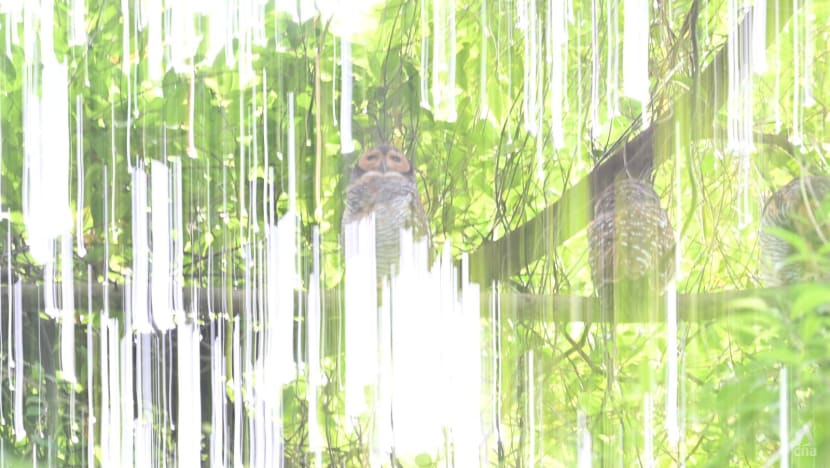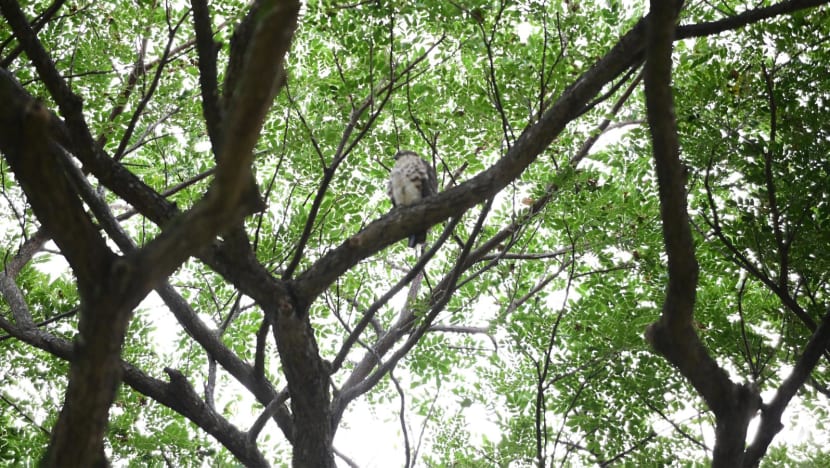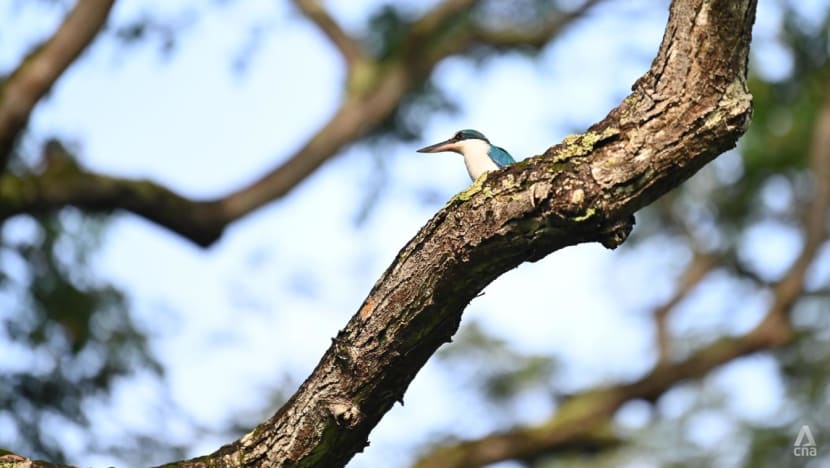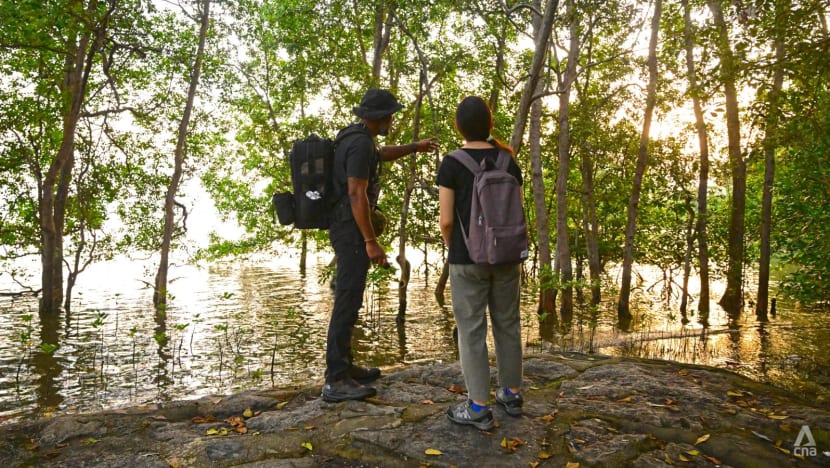What It Takes: Hundreds of hours in the wild for an award-winning photograph
In the final part of a series where CNA journalists spend time with top performers in their fields, Abigail Ng goes searching for wildlife with 2017 National Geographic Photographer of the Year Jayaprakash Bojan.

CNA's Abigail Ng learning the ropes of wildlife photography from award-winning photographer Jayaprakash Bojan. (Photo: CNA/Gaya Chandramohan)

This audio is generated by an AI tool.
SINGAPORE: The first lesson that award-winning nature photographer Jayaprakash Bojan taught me was not how to use a camera, but how to track owls.
We met just past 6am at Pasir Ris Park, and I was fully expecting to walk away from the paths lit by streetlights to search for wildlife in the forested parts of the park.
Instead, he led me towards a restaurant. In the area nearby, there was a constant source of food for spotted wood owls – rats.
“These guys predominantly feed on rats and frogs, they don’t go after other birds,” said Mr Jayaprakash, who was named the National Geographic Nature Photographer of the Year in 2017.
Knowledge about animal behaviour is what helps him locate wildlife that others unknowingly pass by.
“When they look at all the images of the owls that I've been shooting here at Pasir Ris Park, people always ask me: Where do you find them, how do you find them?”
Since owls are nocturnal, he spends early mornings in the park listening for their calls.
“It’s still dark, at about five in the morning,” he said. “Pretty much early in the mornings is when they’re very active, and that’s the only time it’s easy to get them in action.”
He also looks out for bird nest ferns because the owls like to nest in them.
“This is just basic knowledge that will help you easily find your subject,” said the 47-year-old.


Your eyes, ears and nose are your “best friends” when looking for wildlife.
“For example, it’s very easy to smell otter poop. If you want to find otters, (and there’s) fresh otter poop, you know the otters are around or they’ve been around,” said the permanent resident who has lived in Singapore since late 2016.
Outside of Singapore, he may smell fresh tiger urine or look for scratch marks of bears.
He picked up some of this knowledge growing up in South India, where there was a lot of wildlife around him.
“There's really no school of wildlife photography. Most of it you have to invest time in the field.
“And that's how you slowly start picking up on all these little nuances, which makes you a better photographer or a better storyteller,” he said.
TUNED IN TO NATURE
For this story, I met Mr Jayaprakash on five different occasions to watch him in action and try my hand at wildlife photography.
Most of these sessions started early in the morning, which in itself was a struggle for me.
But I quickly realised I had other concerns to worry about, such as why my eyes and ears didn't seem to be pulling their weight.
I heard a lot of birds and animals, but the only sound I recognised came from the wild roosters at Pasir Ris Park. The rest were a cacophony of wildlife sounds to me.
In the darkness of the morning, I could not see much either. We ran into another photographer looking for a buffy fish owl, and Mr Jayaprakash was the first to spot a male holding a rat in his mouth.

He used a soft, diffused torch light to help me see the well-camouflaged owl before circling the tree to find different angles of the bird. Then, he found the female too, who was waiting to receive food from the male.
He assured me that my senses can also be tuned to the different types of wildlife over time.
“Right now even if I’m just cycling and something is going by, it’s literally like you have the peripheral vision. You know something has flown past.”
THE WINNING SHOT
But every animal and every country is different, and he credited a nature guide from Borneo who was with him when he took the photo that won him the National Geographic award.
“Sometimes, some of these projects we do, we go to all these remote locations. You need local support. We are not specialists of those areas,” he said.
“I can’t just randomly one day say, okay, I’ll go next week and find something. It’s going to be hard.”
The people who live there know the bird and animal species in the area.
“A lot of these nature guides, they’re like the unsung heroes,” he said, adding that he gave half of his prize money from National Geographic to his guide.
“I took the picture, and I got all the name and fame. What did he get?” he said. “Those photos were not possible without him.”
The picture that won him an award was of an orangutan standing in a river in Indonesia, peering out from behind a tree.

He was in the country looking to photograph proboscis monkeys when he met some people who told him that they had seen an orangutan hanging around the river. It took him three days before he got the final shot.
“It was kind of a hide-and-seek game that me and the orangutan were playing.”
He got into the water to get a better angle of the orangutan but moved behind a tree because he was afraid the primate would be scared off by him.
The winning image was the first photo he took.
“He was peeping from behind the tree, and I was peeping from behind my tree to see if he was still there, and we had kind of like this eye contact.
“And that was just a brilliant, amazing eye contact because he had the curiosity in his face, inquisitiveness, trying to figure out who is this, what's happening. I think that his expression was just amazing,” said Mr Jayaprakash.

The series of photos that National Geographic published reached millions of people, including a Japanese soap maker who used palm oil in his products.
After reading what Mr Jayaprakash wrote about palm oil cultivation leading to a destruction of habitat and unusual behaviour by orangutans, the soap maker felt compelled to stop using palm oil.
“That was the impact. Sometimes people ask me what’s your motivation. I’m chasing images like this, I’m looking for stories like these because I feel these stories can inspire people, can bring change around us in the way we treat nature,” he said.
THIRST FOR CREATIVITY
He wasn’t always focused on storytelling.
But there was a point, around the time he left the corporate world after nearly 20 years to focus on photography, where he began to question the purpose of the beautiful images he was capturing.
“I started thinking to myself, what am I doing? Why am I doing this? Are my pictures impactful enough? If my pictures are not able to influence anything, then what’s the point?”
He believes there is a “dramatic difference” in the photos he took after 2016.
“It was no longer about just taking beautiful pictures for me.”

That focus on storytelling, he believes, helped him become a more “influential” photographer – a description that he settled on after being asked what sets him apart from other wildlife photographers.
In the creative field, having a “lifelong thirst” to learn more about photography and the natural habitat is what counts, he said.
“The day you think you know it all or you feel like there’s nothing more for you to do … that’s the day I will probably stop being completely creative.
“That’s the day when I should probably let go of my camera and say I’m done.”
PHOTOGRAPHY CHALLENGE
After imparting some of his wisdom to me, Mr Jayaprakash gave me the task of finding and photographing three birds in Pasir Ris Park – a buffy fish owl, a collared kingfisher and a crested goshawk.



He said a good camera can only take me 20 per cent of the way, but the device initially does even less for me because I didn't even know how to use it.
With the help of the internet and my colleague, a visual journalist, I started to get the hang of it. I took some test photos of the ubiquitous chickens and squirrels of the park before trying to complete my task.
Finding the crested goshawk and the buffy fish owl went smoothly with other photographers helpfully pointing them out to me. I also listened to an audio clip of the kingfisher's call, and together with my colleague, managed to spot the smallest of the three birds.
Using a 200mm zoom lens helps, but it could not compete with the 400mm lens that Mr Jayaprakash uses. His gear costs more than S$30,000 (US$22,400) in total.
I tried to move closer to the birds, but they were perched high up – as they typically do – and my neck started to ache from looking up at them. I also struggle to get pictures that are in focus because I set my aperture at f/2.8 as advised.




The setting works well in low light and keeps only a small portion of the photo in sharp focus – but combined with my weak and unstable hands, it produces photos where the bird's chest is in focus, but its head is blurry.
All in, I managed to get three photos, but it felt like I cheated, so I asked to accompany Mr Jayaprakash on one more shoot where he could critique my images.



He adjusted my settings and taught me how to use the environment to frame the subject – such as by moving the camera so that there are some blurred-out leaves in front of the owl.
He also showed me a tree in Pasir Ris Park with leaves that change colour throughout the year. That makes for an interesting picture no matter what species of bird lands on it, but he cannot force it to happen, so he has to wait for the right moment.
DISCPLINE AND DEDICATION
Top wildlife photographers need patience, perseverance and consistency, said Mr Jayaprakash.
It was also a "waiting game" trying to find the buffy fish owl's nest.
He was cycling in the park the first time he spotted the male, which was picking up a small animal from the middle of the path.
The owl flew away, and Mr Jayaprakash followed. He started spending more time in the area, and went to the park even earlier to see if that would help him find out more about the owl.
One day, he arrived at around 4am and saw that the male was not on his usual favourite branch.
“I know that okay, he’s out hunting.” Eventually, he managed to find the nest when he watched the male returning from a hunt with food for the female and the baby.

Going out every day gives you a better chance at capturing a good photo, he said.
“Not many people do this full time because if I’m spending 100 hours – actual filming hours would be maybe threee hours. The rest of the time is just recce, observation,” he said.
It’s hard work, especially when weather conditions overseas are harsh.
“There have been times where I’ve spent days and days and weeks, and I’ve come back with zero pictures or zero videos after having spent thousands of dollars. There’s no guarantee with something like wildlife.”
It has been a rewarding and successful career for him, but Mr Jayaprakash advises those who are interested in wildlife photography to start the way he did – as a hobbyist.
"It will take some time to build a portfolio, so patience is the key. A lot of people lose hope," he said.
If the hobby doesn't work out, you can stick to your day job.
But if you have what it takes? See where the hobby takes you.














